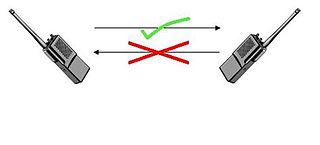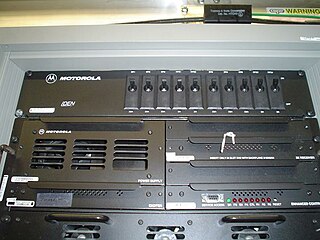
The Open Systems Interconnection model is a conceptual model that characterizes and standardizes the communication functions of a telecommunication or computing system without regard to its underlying internal structure and technology. Its goal is the interoperability of diverse communication systems with standard protocols. The model partitions a communication system into abstraction layers. The original version of the model defined seven layers.
The Session Initiation Protocol (SIP) is a signaling protocol used for initiating, maintaining, and terminating real-time sessions that include voice, video and messaging applications. SIP is used for signaling and controlling multimedia communication sessions in applications of Internet telephony for voice and video calls, in private IP telephone systems, in instant messaging over Internet Protocol (IP) networks as well as mobile phone calling over LTE (VoLTE).
Carrier-sense multiple access with collision detection (CSMA/CD) is a media access control method used most notably in early Ethernet technology for local area networking. It uses carrier-sensing to defer transmissions until no other stations are transmitting. This is used in combination with collision detection in which a transmitting station detects collisions by sensing transmissions from other stations while it is transmitting a frame. When this collision condition is detected, the station stops transmitting that frame, transmits a jam signal, and then waits for a random time interval before trying to resend the frame.
In telecommunication a data link is the means of connecting one location to another for the purpose of transmitting and receiving digital information. It can also refer to a set of electronics assemblies, consisting of a transmitter and a receiver and the interconnecting data telecommunication circuit. These are governed by a link protocol enabling digital data to be transferred from a data source to a data sink.
High-Level Data Link Control (HDLC) is a bit-oriented code-transparent synchronous data link layer protocol developed by the International Organization for Standardization (ISO). The original ISO standards for HDLC are as follows:
In telecommunications and computer networks, a channel access method or multiple access method allows more than two terminals connected to the same transmission medium to transmit over it and to share its capacity. Examples of shared physical media are wireless networks, bus networks, ring networks and point-to-point links operating in half-duplex mode.

A communication channel or simply channel refers either to a physical transmission medium such as a wire, or to a logical connection over a multiplexed medium such as a radio channel in telecommunications and computer networking. A channel is used to convey an information signal, for example a digital bit stream, from one or several senders to one or several receivers. A channel has a certain capacity for transmitting information, often measured by its bandwidth in Hz or its data rate in bits per second.
A collision domain is a network segment connected by a shared medium or through repeaters where simultaneous data transmissions collide with one another. The collision domain applies particularly in wireless networks, but also affected early versions of Ethernet. A network collision occurs when more than one device attempts to send a packet on a network segment at the same time. Members of a collision domain may be involved in collisions with one another. Devices outside the collision domain do not have collisions with those inside.
The Serial Peripheral Interface (SPI) is a synchronous serial communication interface specification used for short-distance communication, primarily in embedded systems. The interface was developed by Motorola in the mid-1980s and has become a de facto standard. Typical applications include Secure Digital cards and liquid crystal displays.
In telecommunications, a point-to-point connection refers to a communications connection between two communication endpoints or nodes. An example is a telephone call, in which one telephone is connected with one other, and what is said by one caller can only be heard by the other. This is contrasted with a point-to-multipoint or broadcast connection, in which many nodes can receive information transmitted by one node. Other examples of point-to-point communications links are leased lines, microwave radio relay and two-way radio.

In telecommunications, point-to-multipoint communication is communication which is accomplished via a distinct type of one-to-many connection, providing multiple paths from a single location to multiple locations.

Simplex communication is a communication channel that sends information in one direction only.

A two-way radio is a radio that can both transmit and receive a signal, unlike a broadcast receiver which only receives content. It is an audio (sound) transceiver designed for bidirectional person-to-person voice communication with other users with similar radios using the same radio frequency (channel). Two-way radios are available in mobile, stationary base and hand-held portable configurations. Hand-held two-way radios are often called walkie-talkies, handie-talkies or hand-helds.
Binary Synchronous Communication is an IBM character-oriented, half-duplex link protocol, announced in 1967 after the introduction of System/360. It replaced the synchronous transmit-receive (STR) protocol used with second generation computers. The intent was that common link management rules could be used with three different character encodings for messages. Six-bit Transcode looked backwards to older systems; USASCII with 128 characters and EBCDIC with 256 characters looked forward. Transcode disappeared very quickly but the EBCDIC and USASCII dialects of Bisync continued in use.

A radio repeater is a combination of a radio receiver and a radio transmitter that receives a signal and retransmits it, so that two-way radio signals can cover longer distances. A repeater sited at a high elevation can allow two mobile stations, otherwise out of line-of-sight propagation range of each other, to communicate. Repeaters are found in professional, commercial, and government mobile radio systems and also in amateur radio.
TCP NAT traversal and TCP hole punching occurs when two hosts behind a network address translation (NAT) are trying to connect to each other with outbound TCP connections. Such a scenario is particularly important in the case of peer-to-peer communications, such as Voice-over-IP (VoIP), file sharing, teleconferencing, chat systems and similar applications.
The Media Gateway Control Protocol (MGCP) is a signaling and call control communications protocol used in voice over IP (VoIP) telecommunication systems. It implements the media gateway control protocol architecture for controlling media gateways on Internet Protocol (IP) networks connected to the public switched telephone network (PSTN). The protocol is a successor to the Simple Gateway Control Protocol (SGCP), which was developed by Bellcore and Cisco, and the Internet Protocol Device Control (IPDC).
A VoIP gateway is a gateway device that uses Internet Protocols to transmit and receive voice communications (VoIP). The general term is ambiguous and can mean many different things. There are many such devices. They are quickly becoming the most common type of voice phone service in many areas.
In amateur radio Morse code operations, QSK or full break-in operation describes an operating mode in which the transmitting station can detect signals from other stations between the elements or letters of the Morse transmission. This allows other stations to interrupt the transmitting station if necessary, and allows a conversational style of communications.





